Italia class ironclads
 Italy (1881) Italia, Lepanto
Italy (1881) Italia, Lepanto
The Italia class comprised two ironclad battleships of the Regia Marina, built between the late 1870s and early 1880s. They were designed by famous engineer Benedetto Brin, which took a radical approach on protection design to profit overall speed, with an exceptionally extensive internal subdivision. Combined with their very large 17-inch (432 mm) guns, they were quite singular vessels which soon attracted the attention of admiralties around the world, notably the Royal Navy, and are now considered “proto-battlecruisers” my many specialists.
They however only served for about thirty years, and had uneventful careers. In the Reserve Squadrons for the last decade they served as training maneuver ships, Lepanto being fully converted into a training ship in 1902 and was discarded in 1915. Italia was modernized in 1905–1908, but also becoming a training ship. They briefly saw action in the Italo-Turkish War of 1911-12 off Tripoli. Italia was still active as a guard ship during World War I, but converted into a grain transport in 1917.
The earliest battlecruisers prototypes
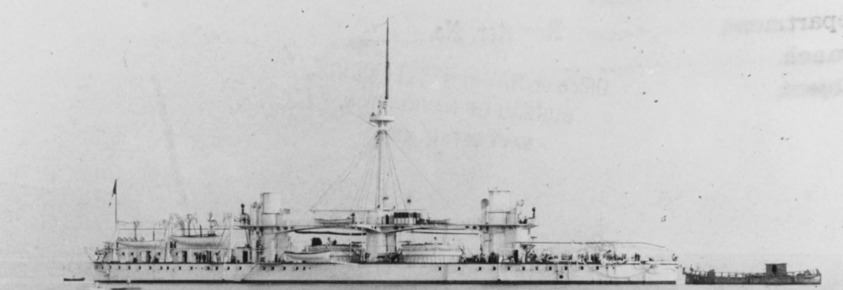
Dandolo, of the previous Duilio class
The Italia and Lepanto followed the path of the Duilio (1879) as innovative ships, in the frame of the wide 1970s naval extension program wanted by Italy to face the Austro-Hungarian Empire at sea. Not content to design (under supervision of Benedetto Brin) the Duilio class, armed with the most powerful naval guns on the planet, four 450 mm (17.7 inches) and nothing else as well as an innovative armour scheme, for the next class, engineers wanted in 1880 to address a main critic over the previous design: Speed. The design they came with was outstanding on many points. Also still heavily armed with barbettes 430 mm guns, they were lightly armoured, very large and roomy, allowing the fitting of a twice larger powerplant, to reach 18 instead of 15 knots and carrying a full infantry division !
Initial development (1875)
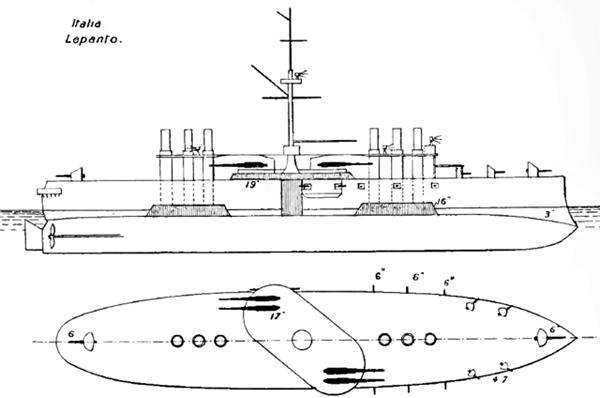
Brassey’s lepanto basic design
This design went back to a long process initiated in the 1870s, digesting the Italian fleet’s defeat at the Battle of Lissa. The Italians started a large naval expansion program aimed at countering the Austro-Hungarian Navy: The Italian class were planned as the second class in this naval program. They were ordered by Admiral Simone Antonio di Saint-Bon, Italian naval minister in 1875, envisioning an improved version of the Duilio class but doubling as a large troop transport as the Navy at the time was given the responsibility of defending Italy’s coastaline.
The work ws naturally given to Benedetto Brin, which prepared an initial design the same year, in 1875. The size was a concerned, as it was to be limited, and developments in armor-piercing shells needed to be taken in consideration. This forced him to take a radical departure over the philosophy behind the Duilio class design. Saint Bon’s requirements were not quite easy to integrate either. Naval designers in Italy believed at the time, no realistic armor thickness (at least forged in italy, with its limited industrial capabilities) or even abroad could resist the impact of an AP shell.
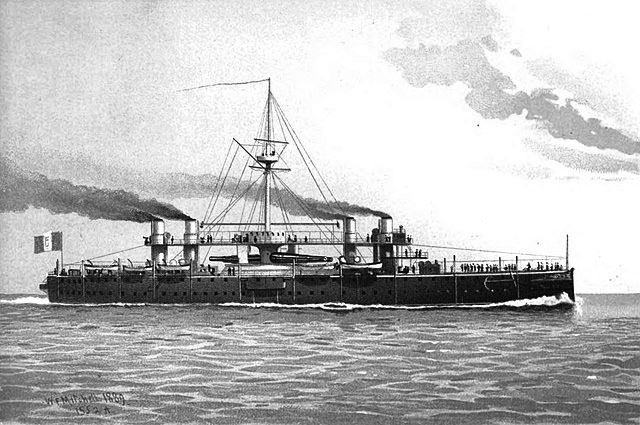
Brassey’s Lepanto engraving, 1888
Brin’s take on this also was also that the great weight of an armor belt (as two could still be placed in sandwich to reach the required thickness) was going haywire and impacted the ship’s speed a great deal. Also at the time, there were still casting and post-treatment mishaps, and Armor plates still tended to shatter or fragment when struck, creating extra damage by projecting shrapnells inside the hull. Her aso believed fitting a classic belt armor would create an unreasonable increase in displacement for the overall design. In the end, his radical conclusion was to discarded it completely, preferring instead a thin armored deck, and thus, taking a complete and radical deaprture over all the world’s ironclads at the time.
Benedetto Brin planned originally a displacement close to 13,850 long tons (14,070 t) standard, with also a main battery of two 17.7 in (450 mm) guns in individual barbettes in échelon like the previous battleships, a common configuration at the time thought as a good compromise as it authorize a better wight distribution and rationalization of armor. The secondary armament was to be eighteen 5.9 in (149 mm) guns and its vast hull internal spaced carried some 3,000 long tons (3,000 t) of coal for a better range, one critic against the previous Duilio class. Although turrets existed at the time, Italy even having the 1860s Affondaore, but Brin opted for open barbettes over heavier enclosed gun turrets as seen on the Duilios.
This measure saved weight, was better for the gun crew in the rather sunny condition of the Mediterranean in general, and allowed the addition of a full upper deck. All these measures were combined to create enough internal space, in a much larger hull, to carry a full Italian division (10,000 soldiers) as per Saint Bon’s requirements. All these design perks made the Italia class very special indeed. The whole concept was never repeated.
Finalisation of the design and construction (1876)
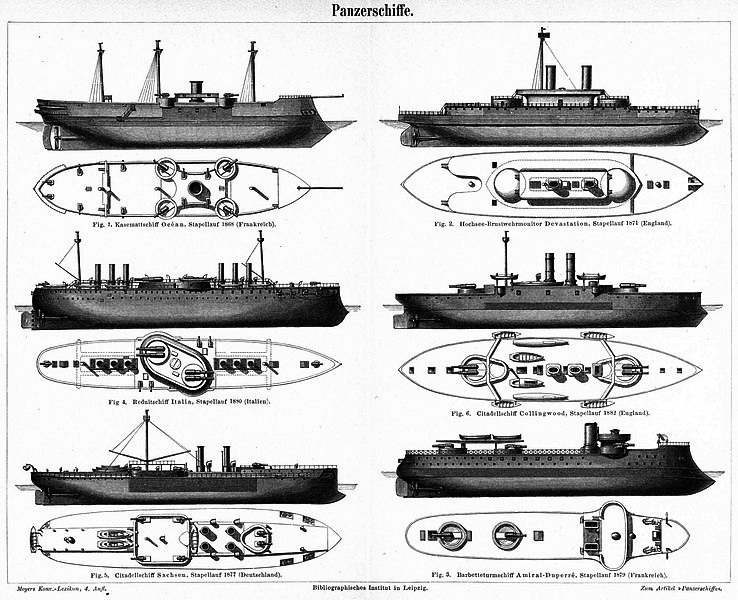
Compared designs of several nations in 1880 (Meyers’ panzerschiffe)
The design evolved in 1876, as per extra developments in recent technologies, whuch brought some changes to Brin’s design, like the latter:
-The Development of slow-burning propellants for the main guns: General Rosset (Italian Army aritllery officer) suggested smaller guns of 17 in (432 mm) with longer barrels had actually the same weight as the 17.7 in guns while providing better muzzle evlocity and thus, penetration power as well as range. This slow-burning propellant participated indeed in the increased muzzle velocity, the longer barrel only raising more this figure. The original guns were purchased by Britain during the Russian war scare of 1878 and Brin altered the barbette design to incorporate Rosset’s ideas and instead two single 45 cm guns, two pairs of 17 in guns were chosen, trigerring many changed in the barbettes themselves, mounts, elevation and training mechanisms, bearings, and the whole reloading apparatus.
-Another change was in the secondary battery, reducing it to eight 6-inch guns for weight issues again and better storage management. The other idea was an upgrade to faster-firing models in the upcoming years, doubling the rate of fire and that additional guns could not have been manned when the 17 in guns were in use.
-The internal coal capacity was brough to 1,700 long tons (1,700 t) over a 15,000 long tons (15,241 t) displacement.
Construction (1876)
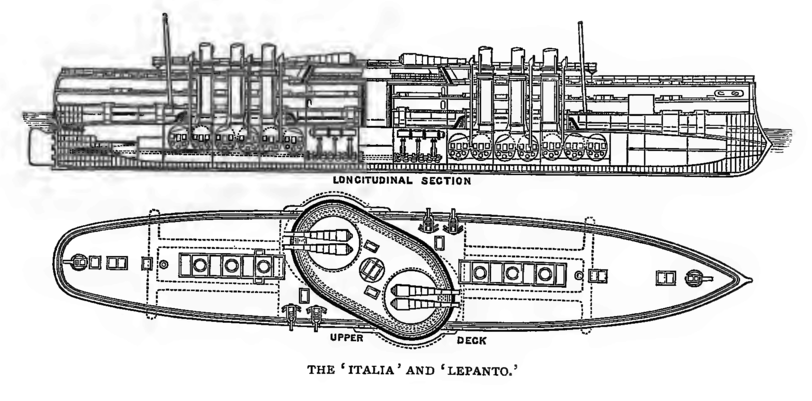
Internal arrangement
Nevertheless, if both ships were already authorized in 1875 and funding allocated to starte construction, design work continued after they were laid down, almost one year apart: Italia was laid down at Regio Cantiere di Castellammare di Stabia () on 3 January 1876, and her sister ship Lepanto at the Cantiere navale fratelli Orlando on 4 November 1876, so 10 months later, leading to some minor differences in design as extra design changes came in between.
The admiralty praised Brin as they thought the ships were much faster and more seaworthy than the preceding Duilio class due to their higher freeboard, almost making them “liners” in appearance. Very large and fast for their time with a massive 15,000 tons displacement at full load they also made quite a splash at the time they were launched in September 1880 and March 1883 respectively. Italia reached 17.8 knots (33.0 km/h) and Lepanto even 18.4 knots (34.1 km/h) after some redesigns and changes.
To put things in perspective, other ironclads of the time were stuck to 15 knots (28 km/h), and their heavy guns were also quite a sight to behold. No doubt they generated many reports from the British naval attaché in Rome as well as in many other navies, needless to say the Austrians and French as well. In 1880, the first had the Kaiser Max class (1875), 3,548 long tons (3,605 t) masted ironclads and casemate ships, ad the larger central battery SMS Tegetthoff (1878) still armed with six 280 mm (11 in) Krupp breech-loading guns, puny in comparison. The French had the Redoubtable (launched 1876), Courbet (1879) and Duperre (1879) in completion, but none were as heavily armed not fast. The admiral Baudin class which construction started in 1879 had only three 370 mm (14.6 in) main guns and a top speed of 15 knots for example.

Design of the launching skid
In short, the Italia class were seen as a really fascinating, yet very risky design. Their high speed combined to a very powerful main battery plus thin armor protection has later naval historians calling these “proto-battlecruisers” of some sort. When first planned, the majority of warships still had slow-firing, cast iron shot guns and the rapid technology changes made the Italia class after entering service in 1885 for Italia, and especially Lepanto in August 1887, sitting ducks against the nex generation of quick-firing guns with explosive shells developed in these late 1880s. This explained teir active service was quite reduced and soon ended as training ships, their large internal accomodations proved ideal for.
Design
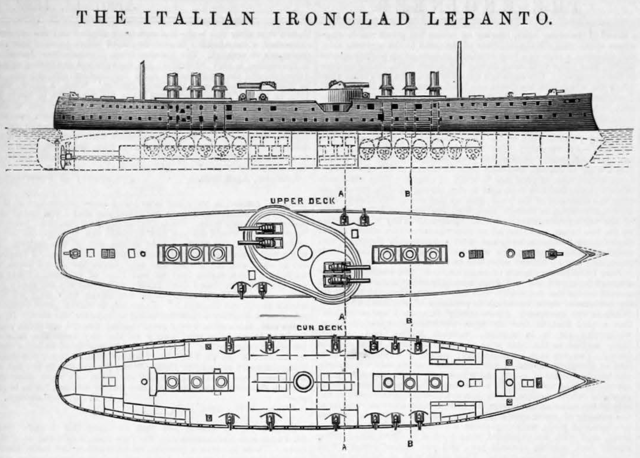
The engineer 1883 – Internal cutaway
Hull and general construction
The Italia class measured 122 meters (400 ft) long (between perpendiculars), 124.7 meters (409 ft) overall for a beam of 22.54 m (74 ft). Lepanto was slightly narrower at 22.34 m (73.3 ft). Both had a different draft of 8.75 m (28.7 ft) and 9.39 m (30.8 ft) for Lepanto, in part of the buoyancy loss due to the smaller beam. Italia’s standard displacement was 13,678 long tons (13,897 t), then rose to 15,407 long tons (15,654 t) fully loaded, her sister ship being heavier (13,336 long tons normal but 15,649 long tons fully laden. Due to their long hull, engineers were able to refine their hull lines considerably, playing not a small part in their overall performances at sea, let down by ventilation and capacity issues. Both has the greatest hydrodynamic efficiency seen on any battleship at the time arguably, with a hull ratio of xxx compared to Duilio’s xxx.
They had in common a reinforced ram bow while the structure was made of steel framing offering greater strenght, for a weight saving of 15% compared to softer iron. Below the waterline their hull was wooden-sheathed and covered with zinc plates to prevent biofouling. However Lepanto was more innovative, fitted for the first time with a double bottom extending for 77.55 meters (254.4 ft), all along the propulsion machinery rooms and ammunition magazines. Both however had no armor belt as indicated, and instead relied into sixty-nine watertight compartments, below the armor deck. The double bottom on Lepanto had an additional eighty-four compartments.
Superstructures, as on the previous ships, were minimal, comprising a single thick military mast and fighting top at the center, fitted with boom cranes. There was a a narrow hurricane deck stretching from the small command bridge structure supported by a derrick. The hurricane deck ran across all six funnels and mast, ending aft. It was high enough not to be affected by the main battery guns blast, or traverse and elevate at maximum elevation. There was also a gooseneck crane for boats installed on the deck aft of the sixth funnel, and a small quartemaster bridge afterwards. Small boats were installed there, far from the blast of the main guns, but others were placed alongside the hull in davits. Some of them were more ofensive in nature (see armament).
Italia’s complement comprised 37 officers and 719 enlisted men, Lepanto 656 enlisted men ans as many officers. With 25 feet (7.6 m) of freeboard and many opening along the sides, there was room enough for troops, although this is not precised in the final plan, and it is believed many should have been located on the deck itself to reach the desired number. Anyway the requirement did not stand out the test of time, both ships were never used that way.
Powerplant

Lepanto in The Engineer, 1883
The Italia’s propulsion system was common to both ships: It comprised four compound steam engines, driving each a single screw propeller. The latter was massive, four bladed, 20 ft 6 in (6.25 m) and in bronze. Brin innovated in what the engines would be run in compound mode for greater fuel efficiency, or direct-acting, for higher speed. That kind of combination was later reproduced in VTE and high and low pressre turbines on more modern ships.
Steam came from twenty-six coal-fired oval fire-tube boilers aboard Italia. On Lepanto Brin chose to fir her with a combination of eight smale oval boilers, but completed by sixteen locomotive boilers. Both engine rooms were placed amidships in separated watertight compartment; Three boiler rooms were placed on either end these. Due to the different boilers used, one sure way to distinguish both sister ships was by their funnels: Six for Italia, four for Lepanto, both in two sets on the centerline, either side of the barbettes. Italia was refitted in 1905–1908 and also was given four funnels. Steering was controlled by a single rudder, steam-driven on Italia and hydraulically-driven on Lepanto.
Projected output for Italia was 18,000 indicated horsepower (13,000 kW) on forced draft so as to reach the design speed of 18 knots (33 km/h; 21 mph). Speed trials were disappointing in that regard as Italia on reached 17.5 knots (32.4 km/h; 20.1 mph) from an output of 15,907 ihp (11,862 kW), maintain it for about an hour. Lepanto was faster at 18.38 knots (34.04 km/h; 21.15 mph) thanks to her more efficient powerplant reaching 16,150 ihp (12,040 kW).
Coal storage on both reached 3,000 long tons (3,000 t), when filling all watertight compartments and even the double hull, but in peacetime, 1,550 long tons (1,570 t) was usual. Their cruising radius for Conway’s All the World’s Fighting Ships was 5,000 nautical miles (9,300 km; 5,800 mi) at 10 knots (19 km/h; 12 mph), while historian Sergie Vinogradov talk of 8,700 nmi (16,100 km; 10,000 mi).
Armour scheme

Internal design of the compound armor
-Instead of a belt armour protection was assured by a mild steel armored deck, a sort of sandwich compound which is difficult to really pinpoint (it was secret at the time anyway). Historian Vinogradov think it was likely 3 to 4.7 inches in thickness (76-115 mm) and in that, diverging records in all sources points in diverging armour schemes on both vessels.
-British intelligence reports of the time gave Italia 4 in (102 mm) in the central section, over the barbette magazines and main powerplant, then reduced to 3 in at both ends and to the bow and stern, like a classic citadel roof. Lepanto for them was 3 in all along.
-This armored deck was sloped downward however, meeting the steel sides 6 feet (1.8 m) above the waterline, then combined with two bulkheads running all along, several feet from the side. There were other bulkheads interspersed also along both main bulkheads, creating a segmented and highly compartimentalized watertight compartments. This created in effect a “cellular raft” designed to detonate precussion shells before penetrating far into the ships but almo limit flooding to a well defined area as well as dampening/containing the bast effect, although the compartments were not filled apparently.
Italia had a compound armor manufactured by Cammell Laird and John Brown & Company in UK, while Lepanto received improved steel developed by French company Schneider-Creusot. Both had a conning tower located forward of the bridge’s derrick. It had wall 11.8 in (300 mm) thick. Barbettes were the heaviest on board, with a composite 19 in (480 mm) armor thickness on the sides, backed with teak 20.5 in (521 mm) thick. Underneath, there were armored tubes which connected the platforms above to the magazines below, with 15.7 in (400 mm) thick walls. Barbettes tops had two layers of 0.59 in (15 mm) so as to protect against shrapnell and small arms fire. Funnels bases were protected down to their boiler uptakes connected with tubes 15.7 in thick (400 mm). So apart the absence of belt, this was pretty impressive overall for the time.
Armament
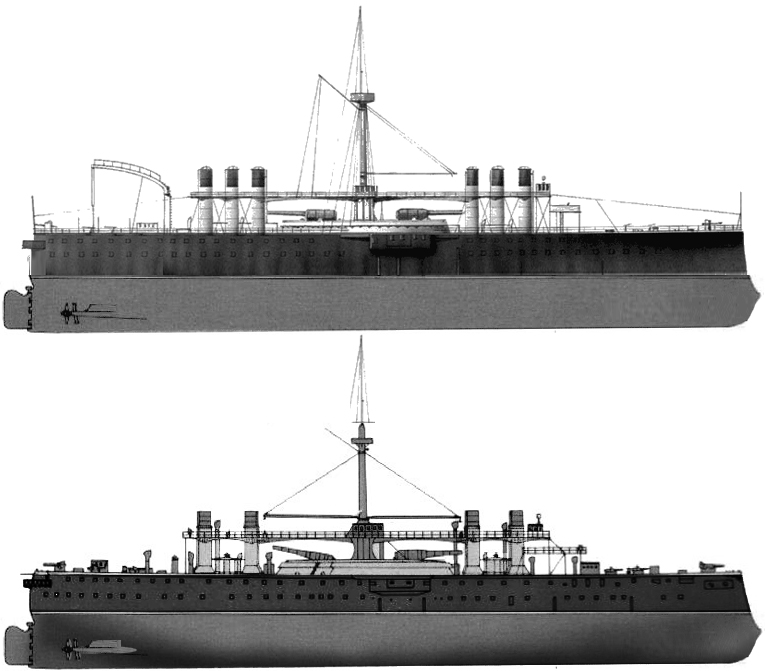
Italia (top) and Lepanto (bottom)
Main armament:
Four Vickers-Armstrong 17-inch (432 mm) breech-loading guns. However they were unequal: Italia had three 26-caliber, one 27-caliber gun, while Lepanto had all same 27-caliber.
-The the 26 cal. Modello A fired a 2,000-pound (910 kg) shell at 1,811 feet per second (552 m/s). This was quite good compared to the Duilio’s 17.7 in guns’ 1,550 ft/s (470 m/s).
-The 27 cal. fired the same shell at 1,903 ft/s (580 m/s).
-Armor penetration was 37.6 in (960 mm) and 39.4 in (1,000 mm), both on a wrought iron plate.
-Rate of fire was one shot every eight minutes, a bit faster than the older muzzle-loading 17.7 in guns as they had to be returned to a fixed loading position each time.
-They were mounted by two in a diagonal and oval barbette, both placed en echelon amidships on turntables port aft and starboard forward.
-The magazine below the armored deck had its ammunition prepared and carried up via an armored trunk.
-Elevation over stern and prow was 45° for both pairs, -10/15° and traverse 360° with interrupting gear to avoid firing on the funnels.
-Ammunition storage vary among sources, from 40/45 shells per gun (45 on Italia) or 50 for both.
-Their high freeboard allowed to mount the guns some 33 feet (10 m) above the waterline, with good arc of fire.
-Due -5° depression and placement they could engage targets as close as 55 m (180 ft), but the useful max range was around 2000 m (6560 feets).
Secondary Battery:
Eight Ansaldo/Vickers single pivot 5.9 inches/26.7 caliber (149.8 mm) for Italia as initially planned, while Lepanto had the new 6 inches (152 mm) 32 caliber.
-They were placed along the hull with a bow-chaser, four broadside forward, a pair astern and the last as stern-chaser.
Tertiary Battery:
Four Ansalso/Vickers 4.7 in (120 mm) guns in single pivot mounts, dismountable to be carried by boat and support landing parties ashore. This armament was changed during two refits in their career (see career).
Torpedo Battery:
Four Whitehead 14 in (356 mm) torpedo tubes placed on the broadside, above the waterline. They carried each a 125 kg (276 lb) warhead, and had a max range of 600 m (2,000 ft).
Small Torpedo/armed picket boats:
For small boats, Italia also included two second-class torpedo boats (served by the aft gooseneck crane) for close defence; They were so small that in service, any rough sea made them useless. The Italians arrived at the same conclusion as the French and British about the born-dead idea of “torpedo boats carriers”. In fact on Lepanto they were replaced by three smaller armed picket boats. In any case, all these boats were usable for a landing party, according to the ship’s initial troop transport requirement. There is no clues either of dismounted artillery or field guns onboard, but a pair of 3 inches (75 mm) mountain guns and two machine guns for these landing parties.
Duilio class Ironclads specifications |
|
| Dimensions | Lenght 109.16 m (358 ft 2 in), Beam 19.74 m (64 ft 9 in), Draft 8.31 m (27 ft 3 in) |
| Displacement | 10,962 long tons (11,138 t), 12,071 t FL |
| Crew | 420 |
| Propulsion | 1 screw, Two compound steam engines, 8 boilers, 7700 hp, |
| Speed | 15.04 knots (27.85 km/h; 17.31 mph) |
| Range | 3,760 nmi (6,960 km) at 10 kn (19 km/h; 12 mph) |
| Armament | 2×2 450 mm, 3 × 14 in (360 mm) TT. |
| Armor | Belt armor: 21.5 in (550 mm), Turrets: 17 in (430 mm), Deck: 1.2 to 2 in (30 to 51 mm) |
Italia class service and modifications
Italia in service
A long construction
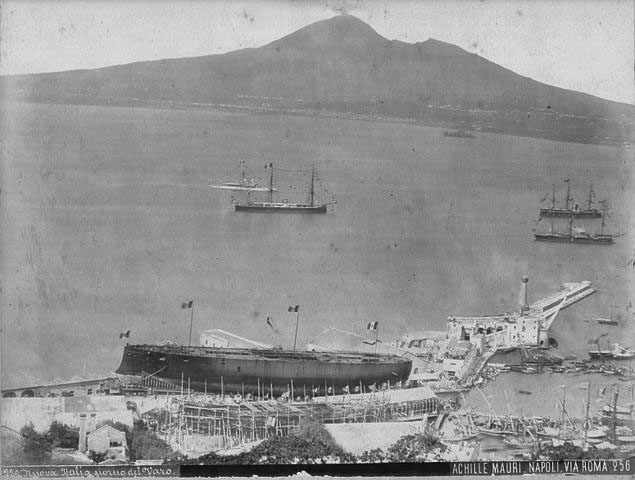
Launch in 1880
RN Italia spent a lot of time in drydock, about ten years, due to numerous design changes during their construction. The same issue plagued French Battleships of the same era, and this made obsolescent when completed, especially regarding their very slow firing main guns. Italia was laid down at Regio Cantiere di Castellammare di Stabia shipyard on 3 January 1876 as “Stella D’Italia” initially (italian star). She had to wait a staggering 4.5 years before launching, on 29 September 1880. Completion had to wait for another five years, on 16 October 1885. Still, this was 22 months before Lepanto, in the works for 11 years !
Italia started her sea trials in December 1885, until March 1886. Failing to reach her designed speed led to an investigation and it apeared in the report this was mostly due to both insufficient steam capacity (or efficiency), and poor ventilation for the boilers, the collectors in place did not draw enough air to burn.
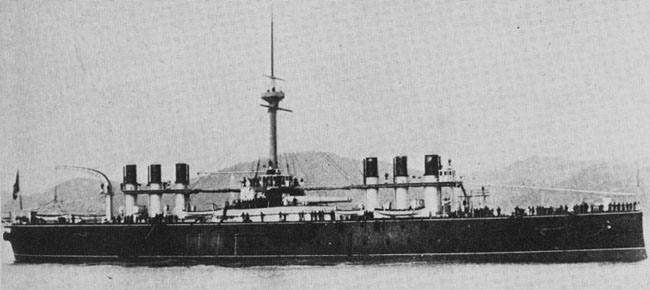
Italia in 1885, as completed.
It was not long after her completion that she received additions, in the fhape of small, fast firing anti-torpeod boat guns: Two 75 mm (3 in) guns, twelve 57 mm (2.2 in)/40 guns, and twelve 37 mm (1.5 in) Hotchkiss revolver cannons plus two machine guns. All of these could be dismounted and added to the firepower of a landing party. They were placed everywhere useful, notably on the deck, in the fighting tops and hurricane deck.
1886-1904 service
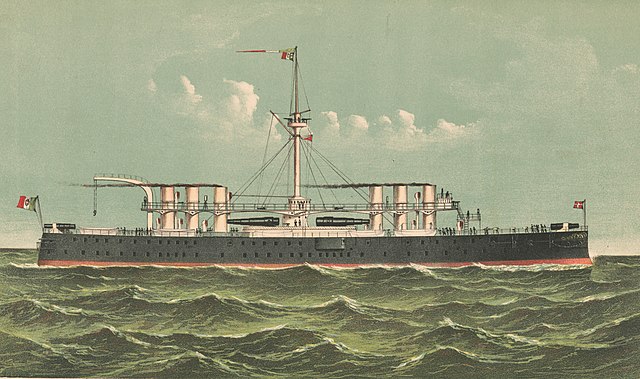
Engraving of the Italia “1st class ironclad”.
After all this, Italia entered service on 10 January 1886, starting her first training cruise in April the same year, and visiting Italian ports (Naples, Palermo, Cagliari, Livorno, Palmas) before reaching ther operating base of La Spezia. In the summer, she headed west, visiting ports in France, Spain, and Portugal. She was assigned to the Squadra Permanente (“Permanent Squadron”) always on the ready, on 11 July, and made a flagship on 1 August under overall command of Vice Admiral Orengo. In October 1886 the squadron departed for a goodwill visit to Greece and the Ottoman Empire. Laid up in 1887 for maintenance, Italia saw no active service, amidst economical problems.
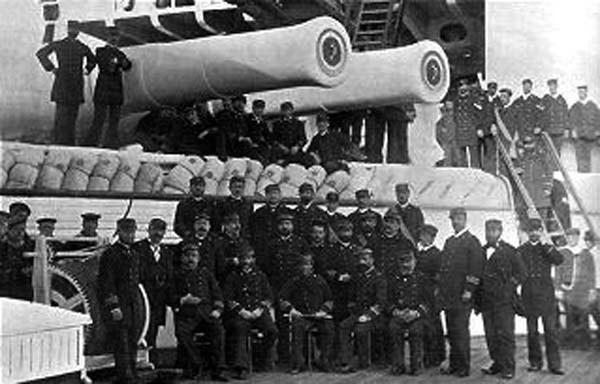
Italia’s officers and guns
Recommissioned in January 1888, back to the Permanent Squadron, she was essential in the annual 1888 fleet maneuvers with her sister ship and the older Duilio, and Enrico Dandolo, as well as the cruiser San Martino and four torpedo cruisers. These combined close-order drills, a simulated attack and alternated defense of La Spezia. Italia took part in the 1889 naval review for the German Emperor Wilhelm II visiting the country. She was placed in reserve in 1890 for the same economic issues, alternating in 1891, 1893 and 1895 (active) and reserve in 1892, 1894, but as flagship of the 2nd Division (Active Squadron) for the 1893 fleet maneuvers. For these, she operated with the new ironclad Andrea Doria and the torpedo cruiser Iride from 6 August to 5 September. They simulated a French attack on the Italian fleet, a realistic scenario at the time. From 14 October 1894 the Italian fleet assembled in Genoa for another naval review held for King Umberto I at the occasion of the commissioning of his namesake battleships, with three days festivities and the King’s visit on all ships.
In 1895, Italia and Lepanto were now permanently held in the Reserve Squadron with the Ruggiero di Lauria and Re Umberto. She became flagship of the 3rd Division, making limited training cruises. Both battleships nearly collided during 1895 fleet maneuvers. From 1896 she became a more specialized gunnery training ship. In July 1896 she became part of the newly created Squadra di Manovra (Maneuver Squadron), as flagship. In 1898, she took part in the annual fleet maneuvers, but afterwards the Admiralty considered her modernization. It was studied a conversion to the new Enrico Dandolo standard, equipped with the new quick-firing 10 in (254 mm) guns. Eventually this was changed to new 13.4-inch (340 mm) guns, but the operation, planned FY 1902 was cancelled as too costly. But she was reconstructed anyway.
Italia’s 1905–1908 refit as training ship
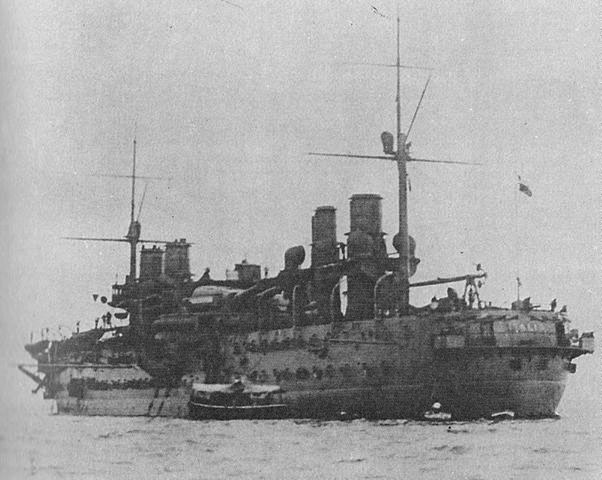
In 1905, Italia went into drydock for the major reconstruction of her career. This had her decommissioned for nearly four years. The changes were:
- Six funnels reduced to four
- Heavy military mainmast removed
- 5.9 in gun removed as well as six 57 mm guns, eight 37 mm revolver.
- Two light pole masts installed for and aft for wireless telegraphy purposes.
- New projectors installed on fighting tops.
- Main guns enclosed in light turrets.
- Boats composition changed.
Back into service in 1909, Italia became a torpedo training ship, permently moored in La Spezia, until 1910. In 1911 she became a barracks ship. However when the Italo-Turkish War broke out that same year, Italia was reassigned to the 5th Division with Lepanto and Enrico Dandolo. By December 1911 the sister ships were prepared sailt to Tripoli and relieved the three Re Umberto-class stationed there. They went to support the beleaguered Italian garrison which just captured the city or Tripoli, with a largely unsafe area. One of the ideas was to spend their large stockpile of obsolete 17 inches shells, but they eventually never fired a shot in anger.
Italia in WWI

Italia in Brindisi, 1915 src
Italia went on as training ship, this time for petty officers in December 1912. In 1914 she was sent to Taranto, used as a guard ship. Laid up on 1 June 1914, she was stricken three days later, so not long before WWI broke out. When the war started, all her secondary guns were removed to be reallocated to ground units and she was towed to Brindisi on 20 April 1915 in order to defend the harbor as Italy went to war, relisted in the naval register on 23 May and fully recommissioned on 1st June 1945 as “first class auxiliary”. On 16 December 1917 she left Brindisi for la Spezia, towed there to be converted into a grain carrier. All her armament was removed but two 4.7 in guns. She was under responsibility of the Ministry of Transport on 1st June 1917 until the end of the war. In July 1919 she was reassigned to the State Railways administration, then returned to the Navy on 13 January 1921 to be properly stricken on 16 November 1921 and BU.
Lepanto in service
Engraving of the Lepanto in Livorno Yard, prior to launch in 1883.
Lepanto was named for the Battle of Lepanto of 1571, and construction dragged on for 11 years with many design modifications in between so she ended quite different from her sister ship. Laid down at Cantiere navale fratelli Orlando shipyard, Livorno, on 4 November 1876, ten months after Italia she spent an amazing 6.5 years on slip before launching, eventually made on 17 March 1883. At that point ot was 2.5 years after her sister; Completion took another 4.5 years, ending on 16 August 1887. In UK, three pre-dreadnoughts were built in the same timeframe. Sea trials started and ended in May 1888.
Commissioned on 14 May 1888, she was assigned to the Permanent Squadron and took part with her sister to the annual fleet maneuvers (also Duilio, Dandolo, and the cruiser San Martino). She was present at the German Kaiser Wilhelm II honorary visit to Italy in 1889 and participated the the next year’s annual fleet maneuvers, First Squadron, with the cruisers Piemonte and Dogali in the Tyrrhenian Sea. The scenario implied defending against an attacking “hostile” squadron.
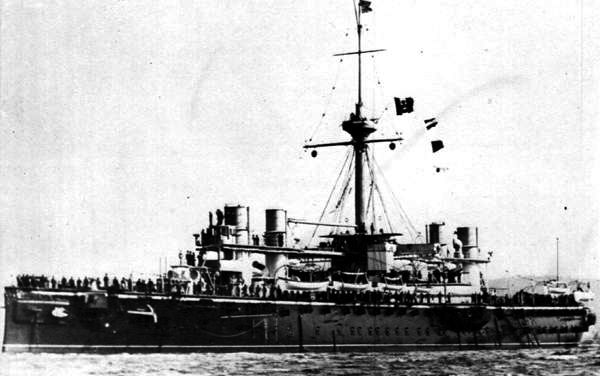
Lepanto, date unknown
In 1891, like her sister ship, as Italy faced economic mishaps she entered a long period of “laternative service”, with a year in reserve each time. Recommissioned in April 1892 she became flagship of the Permanent Squadron at the start of 1893 (Vice Admiral Prince Thomas, Duke of Genoa). On 27 April 1893 she hosted both King Umberto I and Kaiser Wilhelm II in another visit to Italy. She was in 1893 fleet maneuvers with Ruggiero di Lauria, the cruisers Euridice and Monzambano, from 6 August to 5 September. They similated French attackers on the Italian fleet.
Lepanto nearly collided with Italia during these. From 14 October 1894, the fleet was assembled in Genoa for another naval review, in honor of King Umberto I, the occasion beinf the commission of Re Umberto.
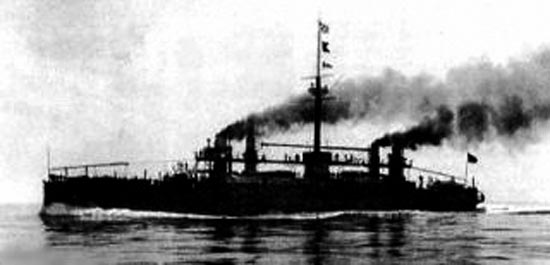
Lepanto in the Mediterranean
In February 1895, Italia and Lepanto were reassigned to the Reserve Squadron with Ruggiero di Lauria and Re Umberto. Unrest in the Ottoman Empire followed by killings of foreign nationals had great European powers sending their fleet to pressure the Sultan for a compensation, and the Italian squadron joined in by November 1895. Lepanto never dropped anchor off Smyrna however. It was part of a larger reinforcement force assembled in Naples (Francesco Morosini, Ruggiero di Lauria, the cruiser Elba, torpedo cruisers Calatafimi and Folgore). Coal and ammunition was stockpile in the event of joing the main force off Smryna, but the order was never given and Lepanto returned to the reserve.
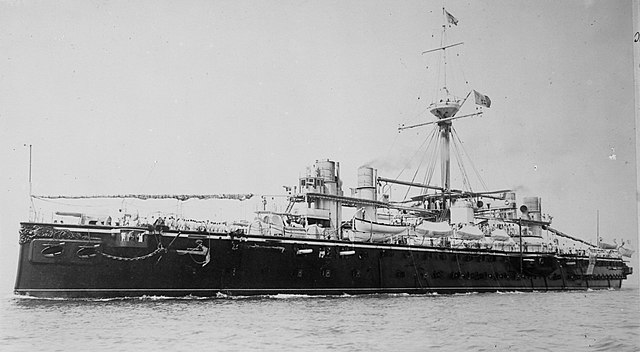
Lepanto as a training ship in the 1890s
She became a training ship, for bridge personnel; from 26 March, and until 20 July 1896. By June 1897, she made a goodwill visit to Britain, representing Italy at the Queen Victoria Diamonf Jubilee Fleet Review. She also took part in the 1897 fleet maneuvers, assigned to the First Division, Reserve Squadron (also Duilio, Ruggiero di Lauria, the cruiser Lombardia). In 1898 Francesco Morosini replaced Duilio and and there were five cruisers. In 1899, the squadron also gained the Re Umberto, Sicilia, and three Ruggiero di Lauria-class ironclads in the Active Squadron, but Italia was only active for eight months, the rest if the year were spent with a sleleton maintenance crews.
The early 1890s saw the admiratlty questioning the obvious obsolescence of Italia and possible modernization. It was chosen to take Enrico Dandolo as a model, with brand new quick-firing 10-inch (250 mm) guns (and armor covers over the barbettes). Eventually she was to gain two pairs of 13.4-inch (340 mm) guns, but the plan was cancelled in 1902 due to budget issues and she was withdrawn from front-line service, by March 1902, now a gunnery training ship in La Spezia. She kept her main guns, four 4.7 in guns, while nine 57 mm, six 37 mm, two machine guns were fitted. Her torpedo tubes were also removed. She joined the Training Squadron in 1904, with Castelfidardo and Affondatore, Flavio Gioia and Caracciolo but took part in annual fleet maneuvers in late 1907, carrying observers.
Lepanto served as a gunnery training ship until 16 October 1910, the was converted as a barracks ship. When the Italo-Turkish War broke out in 1911–1912, she was assigned to the 5th Division with Italia and Enrico Dandolo. In December 1911, Italia and Lepanto were prepared to sail for Tripoli, replacing the three Re Umberto-class there. But this was never carried out. Lepanto was eventually stricken on 26 May 1912, but registered again on 21 January 1913 as a first-class auxiliary ship, train apprentices and specialists, anchored at La Spezia. Stricken for good on 1st January 1914, she sold on 27 March 1915 and BU, unlike her sister ship which saw WWI, but as a grain carrier.
Resources
Links
The History of the Italian-Turkish War, google books
The navy and the nation; or, Naval warfare and imperial defence
Books
NAVI E MARINAI ITALIANI NELLA GRANDE GUERRA, Erminio Bagnasco & Achille Rastelli
Specs Conway’s all the world fighting ships 1860-1905 and 1906-1921.
Beehler, William Henry (1913). The History of the Italian-Turkish War. Annapolis
Brassey, Thomas A., ed. (1889). “Foreign Naval Manoeuvres”. Naval Annual, J. Griffin & Co.
Brassey, Thomas A. (1896). “Chapter III: Relative Strength”. same.
Clarke, George S. & Thursfield, James R. (1897). The Navy and the Nation, Naval Warfare and Imperial Defence. John Murray
Garbett, H., ed. (November 1894). “Naval and Military Notes”. Royal United Service Institution Journal, London.
Garbett, H., ed. (1898). “Naval Notes – Italy”. Same.
Garbett, H., ed. (1902). “Naval and Military Notes – Italy”. Same.
Greene, Jack & Massignani, Alessandro (1998). Ironclads at War, Origin and Development 1854–1891. Da Capo Press
“Italy”. Notes on the Year’s Naval Progress. Washington, DC, ONI 445–48 1895.
Sondhaus, Lawrence (1994). The Naval Policy of Austria-Hungary, 1867–1918. Purdue
Vinogradov, Sergei (2020). “Italia and Lepanto: Giants of the Iron Century”. Osprey.
Model kits
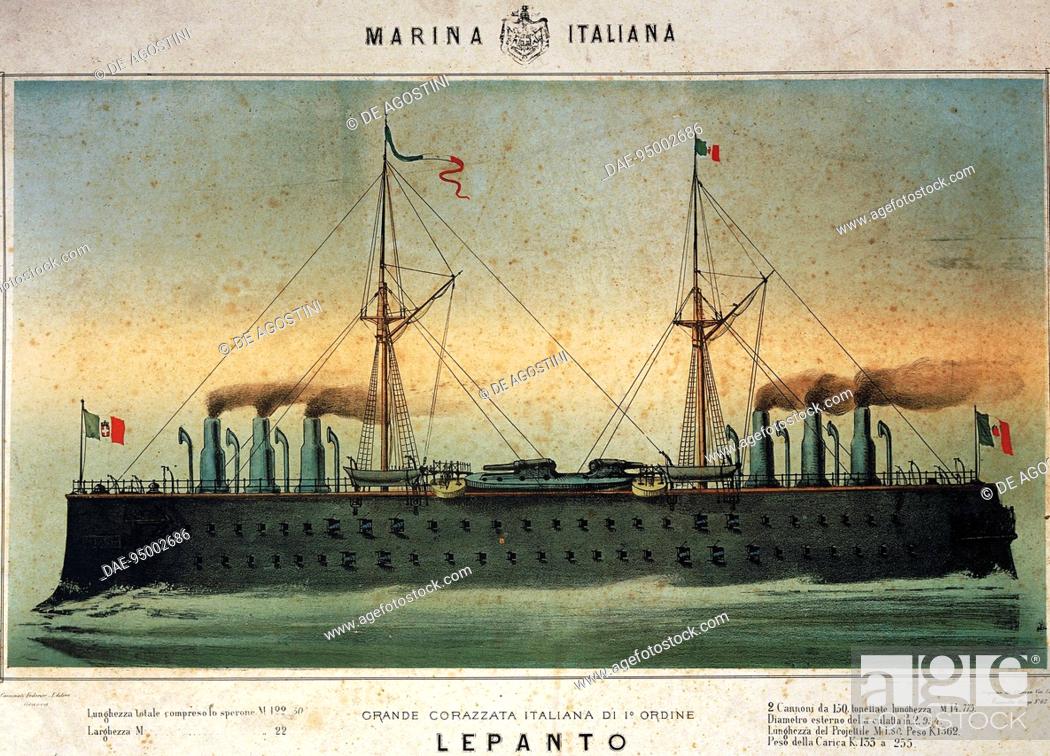


 Latest Facebook Entry -
Latest Facebook Entry -  X(Tweeter) Naval Encyclopedia's deck archive
X(Tweeter) Naval Encyclopedia's deck archive Instagram (@navalencyc)
Instagram (@navalencyc)





 French Navy
French Navy Royal Navy
Royal Navy Russian Navy
Russian Navy Armada Espanola
Armada Espanola Austrian Navy
Austrian Navy K.u.K. Kriegsmarine
K.u.K. Kriegsmarine Dansk Marine
Dansk Marine Nautiko Hellenon
Nautiko Hellenon Koninklije Marine 1870
Koninklije Marine 1870 Marinha do Brasil
Marinha do Brasil Osmanlı Donanması
Osmanlı Donanması Marina Do Peru
Marina Do Peru Marinha do Portugal
Marinha do Portugal Regia Marina 1870
Regia Marina 1870 Nihhon Kaigun 1870
Nihhon Kaigun 1870 Preußische Marine 1870
Preußische Marine 1870 Russkiy Flot 1870
Russkiy Flot 1870 Svenska marinen
Svenska marinen Søværnet
Søværnet Union Navy
Union Navy Confederate Navy
Confederate Navy Armada de Argentina
Armada de Argentina Imperial Chinese Navy
Imperial Chinese Navy Marinha do Portugal
Marinha do Portugal Mexico
Mexico Kaiserliche Marine
Kaiserliche Marine 1898 US Navy
1898 US Navy Sovietskiy Flot
Sovietskiy Flot Royal Canadian Navy
Royal Canadian Navy Royal Australian Navy
Royal Australian Navy RNZN Fleet
RNZN Fleet Chinese Navy 1937
Chinese Navy 1937 Kriegsmarine
Kriegsmarine Chilean Navy
Chilean Navy Danish Navy
Danish Navy Finnish Navy
Finnish Navy Hellenic Navy
Hellenic Navy Polish Navy
Polish Navy Romanian Navy
Romanian Navy Turkish Navy
Turkish Navy Royal Yugoslav Navy
Royal Yugoslav Navy Royal Thai Navy
Royal Thai Navy Minor Navies
Minor Navies Albania
Albania Austria
Austria Belgium
Belgium Columbia
Columbia Costa Rica
Costa Rica Cuba
Cuba Czechoslovakia
Czechoslovakia Dominican Republic
Dominican Republic Haiti
Haiti Hungary
Hungary Honduras
Honduras Estonia
Estonia Iceland
Iceland Eire
Eire Equador
Equador Iran
Iran Iraq
Iraq Latvia
Latvia Liberia
Liberia Lithuania
Lithuania Mandchukuo
Mandchukuo Morocco
Morocco Nicaragua
Nicaragua Persia
Persia San Salvador
San Salvador Sarawak
Sarawak Uruguay
Uruguay Venezuela
Venezuela Zanzibar
Zanzibar Warsaw Pact Navies
Warsaw Pact Navies Bulgaria
Bulgaria Hungary
Hungary

 Bundesmarine
Bundesmarine Dutch Navy
Dutch Navy Hellenic Navy
Hellenic Navy Marina Militare
Marina Militare Yugoslav Navy
Yugoslav Navy Chinese Navy
Chinese Navy Indian Navy
Indian Navy Indonesian Navy
Indonesian Navy JMSDF
JMSDF North Korean Navy
North Korean Navy Pakistani Navy
Pakistani Navy Philippines Navy
Philippines Navy ROKN
ROKN Rep. of Singapore Navy
Rep. of Singapore Navy Taiwanese Navy
Taiwanese Navy IDF Navy
IDF Navy Saudi Navy
Saudi Navy Royal New Zealand Navy
Royal New Zealand Navy Egyptian Navy
Egyptian Navy South African Navy
South African Navy






























 Ukrainian Navy
Ukrainian Navy dbodesign
dbodesign